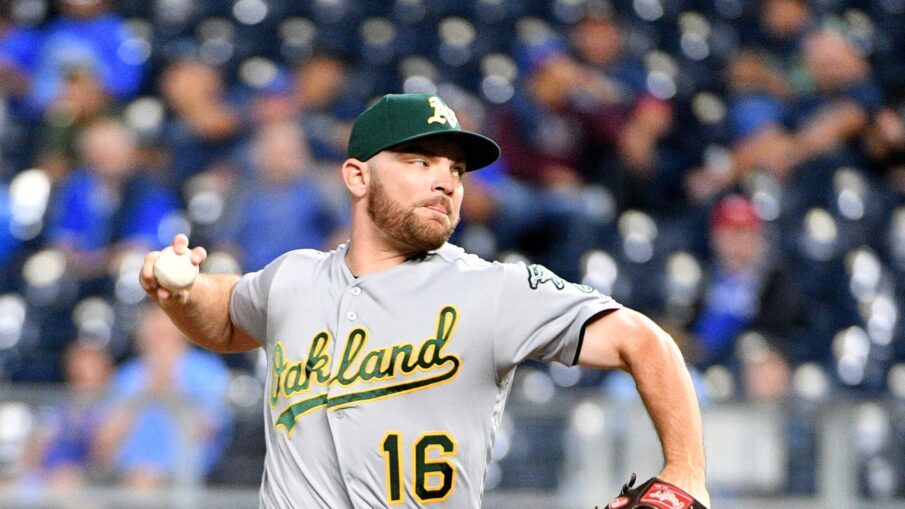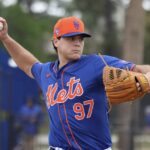Liam Hendriks, Relief Pitcher
Bats/Throws: Right/Right
Age: 31 (Feb. 10, 1989)
Traditional Stats: 24 G, 25.1 IP, 1.78 ERA, 0.67 WHIP, 37 K, 3 BB, 1 HR; 13.1 K/9, 1.1 BB/9, 0.4 HR/9, 70.5% LOB
Advanced Stats: 32.0% GB, 5.3% HR/FB, 1.14 FIP/2.07 xFIP, 1.90 SIERA, 235 ERA+, 1.4 fWAR/1.4 bWAR
Statcast Percentiles: 17th exit velocity, 76th hard-hit, 87th barrel, 78th xBA, 98th xwOBA, 83rd xSLG, 98th xERA, 98th K%, 92nd Whiff%, 87th fastball velocity, 85th fastball spin, 19th curveball spin
Rundown
Liam Hendriks has been a reliable component of the Oakland Athletics’ pitching staff since 2016, making at least 50 appearances in four of his last five seasons prior to a pandemic-shortened 2020. The last two years in particular, however, have forced Hendriks’ name into the conversation as one of the most dominant relievers in baseball.
Holding down the ninth inning for the best bullpen in the American League, the Australian flamethrower locked down 14 saves in 15 opportunities, allowing the fourth-fewest baserunners per inning among qualified relievers. Only Tampa Bay’s John Curtiss and Milwaukee’s Brent Suter could top Hendriks’ 12.33 K/BB ratio, and only rookie right-hander Devin Williams managed as many wins above replacement.
It would normally be justified for fans, analysts, and executives alike to fear how these numbers regress beyond a campaign of 24 appearances, but rest assured, Hendriks has been here before.
Just a year prior, the righty stepped into the closer’s role shortly after Blake Treinen stumbled out of it, and the results included, but were not limited to, a 1.80 ERA, 3.9 fWAR, an All-Star Game nomination, and a selection to the all-MLB Second team. He also cracked the 90th percentile or higher in seven of the 12 conventional Statcast metrics, though his exit velocity (19th) and curveball spin (9th) figures remained bottom-tier.
Hendriks’ transformation from a trustworthy seventh-inning arm to a force of filth began on a note similar to that of many successful relievers both past and present: demotion to Triple-A. Entering the final week of June 2018 with an ERA north of seven, the righty was designated for assignment and ultimately sent outright to Oakland’s Triple-A affiliate in Nashville. He returned in September of that year with a four-seam fastball a full three miles per hour faster than the 93 he’d averaged all year.
The Athletics took note, appointing him to serve as a first-inning opener as the team scrambled for an American League Wild Card berth. Opponents hit just .178 off Hendriks in the final month, and his 1.38 ERA in that time earned him the start in Oakland’s wild-card playoff in the Bronx.
By 2019, Hendriks had abandoned his sinker and returned with nearly an entire inch of vertical movement on his four-seamer. He also debuted a curveball, totaling 2.6 runs above average with the pitch – a full run above that of Seth Lugo. Both revisions within his repertoire made his slider, a once hittable breaking ball, all the more difficult to sniff out, as pitch value climbed from -0.9 to 9.9 runs above average – good for 10th in the big leagues. His strikeout rate followed, rising from a pedestrian 21.2% in 2018 to the eighth-best among relievers in 2019 (37.9%).
Hendriks’ splits between righties (.135/.148/.154 in 2020) and lefties (.200/.243/.314) are equally impressive, and he has a clean bill of health since he first returned to the A’s organization. His time ambling around the wires with the Minnesota Twins and Toronto Blue Jays as a long-reliever cloud his profile compared to some of his more experienced high-leverage counterparts like Aroldis Chapman and Kenley Jansen, but Hendriks’ stuff is very real, and it’s translated into some shockingly real numbers over the last two seasons.
Contract
Save for his DFA scare in mid-2018, Hendriks has never seen the free agent market since he first debuted with the Twins in 2011. He had been claimed off waivers by the Orioles and Cubs before settling the third time in Toronto, but has been getting by on league-minimum and recommended arbitration figures for the better part of his career.
His 75 appearances in 2019 helped him reel in a $5.3 million salary, which of course became prorated when the first 102 games of the big-league season were lost to the COVID-19 shutdown. The year prior, the Athletics tendered him $2.15 million. Needless to say, he’s going to earn every cent of the upcoming sweepstakes.
The relief options behind Hendriks don’t make for the most assuring of alternatives: Brandon Workman and Sean Doolittle both struggled mightily… Kirby Yates (elbow inflammation) saw little action in 2020, and Ken Giles (Tommy John surgery in September) won’t see any in 2021. Trevor May, Blake Treinen, and Tony Watson all impressed, though none in the same patented ninth-inning role.
Will Smith (three years, $40 million), Drew Pomeranz (four years, $34 million), and Will Harris (three years, $24 million) each came away with secure multi-year deals as the brightest names of their class. It’s hard to trace what Hendriks’ contract will look like in the wake of a season in which every team has claimed to lose significant money, but between $10-14 million a year over more than two years seems a safe bet.
Hendriks is a client of Rep1 Baseball, which currently represents the likes of Ronald Acuna Jr., Rafael Devers, Edwin Diaz, Eloy Jimenez, Luis Severino, and impending free-agent outfielder Starling Marte. Though the group certainly failed to pry money from Acuna’s bosses in Atlanta last year, Hendriks still commands quite a price as easily the best reliever in an otherwise lukewarm pool.
Recommendation
The question of whether or not the Mets should pursue Liam Hendriks can be answered simply enough by looking at both his numbers, his makeup, and his trajectory. He isn’t a groundball pitcher, which spares us from having to watch this infield struggle to support him. Furthermore, he would easily be a more reliable closer than Diaz, and probably Lugo as well, and moving both incumbents down to setup roles would further prepare the bullpen for high-leverage situations.
The only issue at hand actually has little if anything to do with Hendriks’ credibility and everything to do with the ethics of constructing a lockdown bullpen.
Constructing a relief corps through multiple ever-expensive channels of free agency is an ill-advised strategy, and it’s one that the Mets have unsuccessfully taken up several times in the past three offseasons, even with the more conservative spending standard the Wilpons always held themselves to.
Beneath Lugo, Diaz, and Hendriks – the latter of whom will command quite a price – the club would still be obligated to pay (and pitch) Jeurys Familia and probably also Dellin Betances as well (unless he declines his player option and opts for a likely pay cut with another team).
With a smarter front office, the Mets could fill the remaining two to three spots with pitchers who are at the same precipice of their careers as Hendriks before his 2019 breakthrough, but at that point it begs another important question: why not just smarten up in scouting for relief pitchers, use those smarts to groom a promising pitcher we have yet to hear about for the same high-leverage role, and then allocate Hendriks’ money toward a more pressing cause? (like catcher, center field, or the starting rotation)
Signing veterans (like Betances, Familia, Justin Wilson, and Anthony Swarzak in winters past) and trading for high-profile arms (namely Edwin Diaz) run a risk we’re all too familiar with of bad performance and/or injury.
However, even the deals with relievers that succeed, like Wilson and (hypothetically) Hendriks, for instance, wind up blocking (or altogether eliminating) routes to cheaper, younger, perhaps even more promising arms. Consider where the Mets’ bullpen could have been, for instance, if it had lent itself the flexibility for the likes of Drew Smith, Robert Gsellman, and Hansel Robles to adequately develop.
Hendriks’ emergence, along with Oakland’s bullpen at large and perhaps even those of the Rays, Dodgers, and Brewers, should serve as a lesson to our incoming ownership regime that constructing a bullpen has little to do with throwing money at the best available veterans, and everything to do with sustainable player development and thrifty analytics.
Of course, with both the finances of the new ownership group and the brain trust of a front office spearheaded by Sandy Alderson, you can have your cake and eat it, too: the team could commit to a smarter plan in developing and scouting pitchers while using the short-term window of opportunity to break the bank on Hendriks.
We’ve simply never seen this organization pull off a victory of that caliber, and as a result, I can’t comfortably think in more than one modality. Hopefully this is the offseason that changes.















